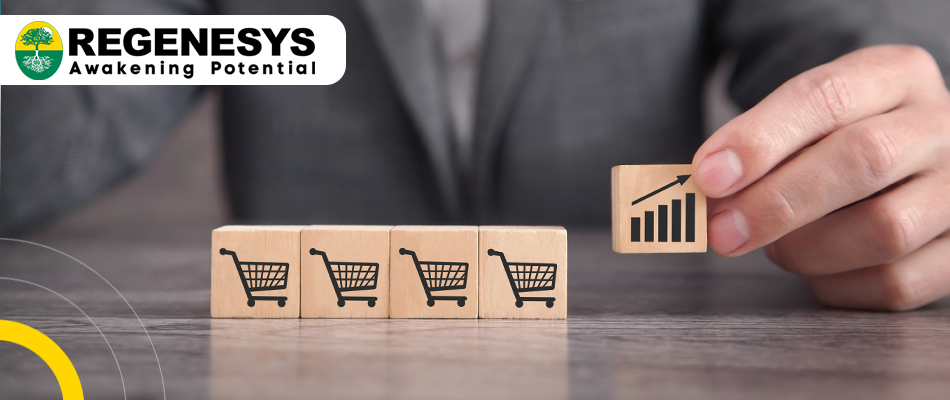In today’s fast-paced and technology-driven world, the retail industry constantly evolves to meet consumers’ changing needs and preferences.
The rise of e-commerce and the ever-increasing influence of social media have significantly impacted consumer behaviour, ultimately reshaping how retailers operate.
In this article, let us explore the key factors driving changing consumer behaviour and discuss how retail management can adapt to these changes to stay competitive.
Table of Contents

What Is Retail Management?
Retail management oversees a business’s day-to-day operations and strategic planning to ensure efficient functioning and success.
Retail management encompasses a wide range of activities, Including:
- Financial planning,
- Inventory management and
- Customer service marketing.
Retail managers play a pivotal role in:
- Meeting the financial goals
- Objectives of the retail establishment and
- Delivering a positive shopping experience to customers.
Retail management is dynamic and can vary significantly depending on the:
- Type of retail business,
- Size of retail business and
- The specific niche of retail business.
Retail management requires:
- Adaptability
- Customer focus
- Business acumen and
- Leadership skills to respond to the ever-evolving retail landscape and consumer preferences.
Successful retail managers are adept at balancing the needs of the business with those of the customers to drive sales and ensure a positive shopping experience.
Key Factors Driving Changing Consumer Behaviour
A wide range of factors influences consumer behaviour, and it can change over time due to various dynamics in society, technology, and the economy.
Several key factors that have been driving changing consumer behaviour in recent years include:
Technological Advancements:
- Rapid technological advancements have transformed how consumers:
- Shop,
- Communicate, and
- Access information.
- The widespread use of smartphones, e-commerce platforms, and social media has made online shopping more convenient and accessible, altering traditional shopping patterns.
E-commerce Growth:
- The rise of e-commerce giants like Amazon and the expansion of online shopping options have led to a significant shift in consumer behaviour.
- Many consumers now prefer the convenience of shopping online, which offers:
- A broader product selection,
- Competitive pricing and
- Doorstep delivery.
Social Media Influence:
- Social media platforms have become powerful tools for product discovery and recommendation.
- Influencers and user-generated content on platforms like:
- Instagram,
- TikTok, and
- YouTube can significantly impact consumer choices and brand preferences.
Health and Wellness Trends:
- Growing awareness of health and wellness has influenced consumer behaviour.
- Consumers increasingly seek:
- Healthier food options,
- Sustainable products, and
- Fitness-related purchases.
Environmental Concerns:
- Climate change and environmental sustainability have become essential considerations for consumers.
- Many choose eco-friendly and sustainable products and expect companies to adopt environmentally responsible practices.
Retail Management: Adapting to Changing Consumer Behaviour.
Adapting to changing consumer behaviour is a critical challenge for retail management. As consumer preferences and shopping habits evolve, retail businesses must stay responsive and innovative to remain competitive.
Here are some strategies for retail management to adapt to changing consumer behaviour:
Data-Driven Decision-Making:
- Utilise data analytics to gain insights into customer behaviour.
- Collect and analyse data on:
- Purchase history,
- Website interactions and
- Customers’ feedback to understand trends and preferences.
- Use predictive analytics to forecast consumer trends and adjust inventory, pricing, and marketing strategies accordingly.
Multi-Channel Retailing:
- Embrace multi-channel retailing by offering products through various channels, including:
- Physical stores,
- Mobile applications
- E-commerce websites and
- Social media platforms.
- Ensure a seamless and consistent shopping experience across all channels, allowing customers to switch between them effortlessly.
E-commerce Enhancement:
- Invest in user-friendly e-commerce platforms with intuitive navigation and mobile optimisation.
- Provide secure and convenient online payment options.
- Implement features such as:
- Reviews,
- Product recommendations and
- Personalised shopping experiences to engage online shoppers.
Brick-and-Mortar Innovations:
- Revamp physical store layouts to enhance the in-store experience.
- Consider experiential retail concepts like:
- In-store events,
- Interactive displays, or
- Product demonstrations.
- Integrate technology, like self-checkout kiosks and augmented reality displays, to streamline the shopping process and engage customers.
Personalisation and Customer Engagement:
- Implement personalisation strategies by tailoring product recommendations and marketing messages to individual customers based on their preferences and past behaviours.
- Engage with customers through:
- Social media,
- Email marketing and
- Loyalty programmes to build relationships and inform them about promotions and new arrivals.

The Bottom Line
Retail management must adapt to changing consumer behaviour to stay competitive in today’s dynamic marketplace.
Retailers can meet their customer’s evolving needs and expectations by:
- Embracing technology,
- Prioritising sustainability,
- Leveraging social media,
- Emphasising customer service and
- Enhancing the online shopping experience,
Thus, those who successfully adapt will survive and thrive in the ever-changing retail landscape.
Stay tuned with Regenesys Business School to explore how retailers can adapt to changing consumer behaviour.
Learn how to manage a business or start your own by developing leadership and management skills with the Regenesys MBA – Master in Business Administration courses.
Enhance productivity and diversity with our MBA – masters in business administration programme, designed and facilitated by industry and subject matter experts.
Regenesys Business School has proven to be one of the fastest-growing and leading MBA business schools, providing management courses, business courses, and business administration courses. Sign up @ Regenesys Business School to learn more about the MBA programme.
FAQs
What Is Consumer Behavior?
Answer: Consumer behaviour studies the processes and activities that individuals, groups, or organisations use when searching for:
- Selecting,
- Purchasing,
- Using, and
- Disposing products, services, ideas, or experiences to satisfy their needs and wants.
Consumer behaviour is a multidisciplinary field that combines elements of
- Marketing,
- Sociology,
- Economics,
- Psychology and
- Anthropology.
Consumer behaviour is the study to understand why and how people make decisions related to consumption.
How does globalisation drive changing consumer behaviour in recent years?
Answer: Increased globalisation has expanded consumer access to products and services worldwide.
This has led to greater cultural diversity in consumption patterns and preferences.
Why Retailers Should Adapt To Changing Consumer Behaviour?
Answer: In today’s rapidly changing retail landscape, staying adaptable and customer-centric is vital to long-term success.
To meet the ever-shifting demands and expectations of shoppers, Retail management should regularly:
- Assess consumer behaviour,
- Experiment with new strategies and
- Be willing to evolve.
How do urbanisation and mobility drive changing consumer behaviour in recent years?
Answer: Urbanisation trends and increased mobility have influenced how consumers live and shop.
Urban dwellers may have different consumption patterns and transportation needs than rural areas.
What are the Key aspects and components of consumer behaviour?
Answer: Key aspects and components of consumer behaviour include:
- Needs and Wants,
- Consumer Ethics,
- Market Research,
- Purchase Behavior,
- Consumer Psychology,
- Influencing Factors,
- Decision-Making Process,
- Global Consumer Behavior,
- Cultural and Social Influences,
- Consumer Satisfaction and Loyalty,
- Online and Mobile Consumer Behavior.






